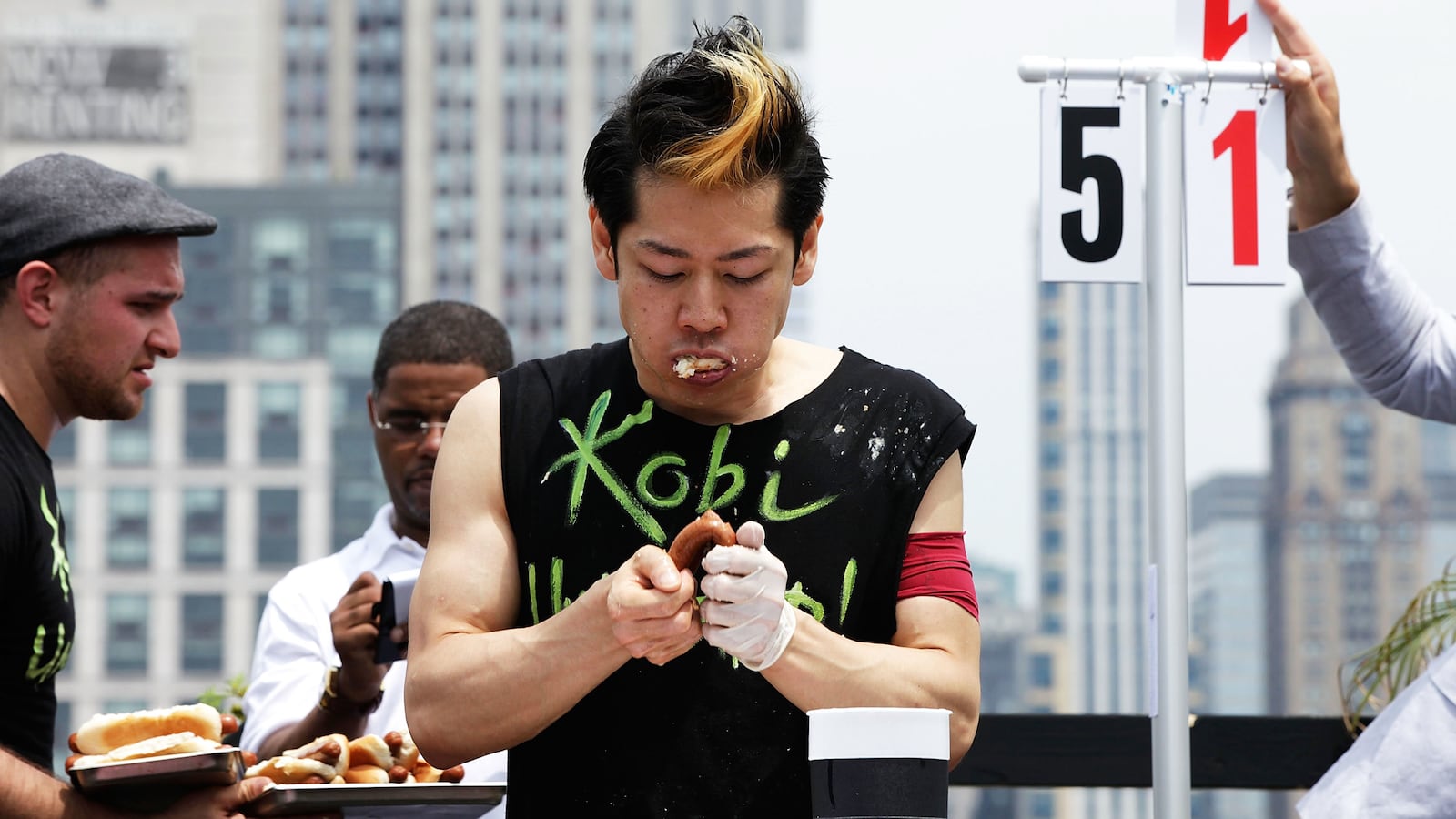A select few athletes are so iconic, they’re known by a single name. Jordan. The Babe. Serena. Pelé. Tiger. Shaq.
And, of course, Kobayashi.
The godfather of competitive eating, Takeru Kobayashi burst onto the American scene at the 2001 Nathan’s Hot Dog Eating Contest, where the lithe 5-foot-8 Japanese 23-year-old, using a revolutionary water-dipping technique and a body-wiggling maneuver known as the “Kobayashi Shake,” ate an astounding 50 hot dogs—double the prior record. That feat thrust Kobayashi to instant superstardom, and his subsequent five wins at the famed July 4th competition only solidified his standing as the king of the eating world—a title he’d only officially relinquish in 2007, when American Joey Chestnut dethroned him at the Nathan’s extravaganza.
The tumultuous saga of Kobayashi and Chestnut is the subject of ESPN’s latest “30 for 30” documentary, The Good, The Bad, The Hungry, which details the stratospheric rise and controversial fall of Kobayashi, whose reign was cut short by losses to Chestnut (winner of 11 Nathan’s contests, and a multi-world record holder), a falling-out with Major League Eating (MLE) and its co-founder George Shea, and an eye-opening arrest at the 2010 Nathan’s event. It’s an alternately thrilling, funny and messy tale of rivalry, innovation, ambition and engorged stomachs, and one that feels like it’s the prelude to a Rocky-style comeback sequel in which Kobayashi returns to the MLE fold to once more take on Chestnut.
Asked about that possibility shortly before the July 2 premiere of The Good, The Bad, The Hungry, however, Kobayashi sounds less than hopeful, thanks to the lingering bad blood between the two. “We don’t get along—I don’t like him, he doesn’t like me. But that’s just the way it turned out to be. We’re totally different people,” he says (via his manager, wife and translator, Maggie James). “I have called him out to competitions a few times, after I left Nathan’s, but he won’t come. So that’s his thing; he doesn’t want to do it anywhere else.”
Not that Kobayashi is particularly eager to get back in the proverbial ring with Chestnut. “Yes, if he came out and he wanted to compete—or the people really said we want to see you compete—and it was not on that [MLE] stage with those people, I would do it, of course,” he confirms. Nonetheless, “If you ask me, do I want to compete with him? Mmm, not necessarily. I don’t even want to be in the same room with him. The face he gives you in the movie—he says something different every time, so it’s difficult for me to trust that those are his words, or if they’re George Shea’s scripted words, and where his feelings are coming from. It’s stressful for me to compete against, much less be around, a person who has that kind of personality. So I just choose not to be around him.”
Kobayashi’s issues with Chestnut are, as Nicole Lucas Haimes’ documentary lays out in entertaining fashion, directly related to his problems with MLE founder Shea, who alienated Kobayashi in the mid-2000s by locking him into contracts that only allowed Kobayashi to compete in MLE-sanctioned events. That rift came to a head at the 2010 competition, when Kobayashi refused to participate—and then, after jumping on the Nathan’s stage while wearing a “Free Kobi” T-shirt, was arrested and taken away in handcuffs. The legend has never returned to Nathan’s annual July 4th spectacular, and according to him, he never will.
“I don’t like their mentality, and so I have no desire at all to go back there,” he explains. “After enjoying my own freedom, I’ve realized I have this growing sense of how satisfied and happy I am that I made the choice to not be with something I didn’t believe in. So it’s hard to find any desire to go there again.” Much of that happiness comes from his distance from Shea, who presents himself in The Good, The Bad, The Hungry as a carnival-barker promoter more concerned with drumming up media attention than creating a level playing field. For Kobayashi, Shea remains a toxic force in the world of competitive eating.
“As you’ll see in the movie, George Shea even admits that he scripts things, and writes the narrative. For me, I don’t trust that kind of person at all. How am I supposed to be serious about something when I know that that person is manipulating things all the time?” he asks. “It’s a manipulation game for him. If I always have to wonder what the truth is, or that they’re going to manipulate the truth when I’m taking something so seriously—I can’t be around a human that I can’t trust.”
Kobayashi claims that the Shea seen in Haimes’ film is, in fact, a far more palatable version than the one he knows. “I thought, that was a much kinder, lighter [Shea] than how he really is in real life. He’s really much worse in real life. In the movie, he tries to show himself as, ‘I just think about press all the time. I’m just a press man.’ He keeps saying that, but it’s not true. In real life, yes, he does anything for press, but that’s the light version of it. In real life, he’s a manipulator, he’s a con artist, he calculates everything—to spread lies before the truth can even be heard, to cover things up, and to manipulate the rules of the sport. He’s scripting everything. He’s not just a press man; he’s much worse than that.”
Lest one think that Kobayashi is simply sitting around fuming, the 41-year-old athlete still regularly eats competitively. “I still compete. I just want to compete in a very, very serious league where things have evolved to make it more of a sport, instead of being part of a scripted joke,” he proclaims with pride. “You may think that it hurts me to walk away from [the MLE], but that’s not how it goes at all. I’m very serious, and I take what I’m doing very seriously. When I think of [Shea] or the MLE or the Nathan’s competition creating a script, and me taking so much time and energy to focus on my best records and how I can be the best athlete I can be, it hurts to be on a stage like that where you know they’re not judging you fairly. They’re changing the numbers, they’re doing what they want.”
And then, to put it more bluntly, he says about the MLE, “It’s a joke. They were making a joke of me.”
Despite his ongoing success in the field he first brought to international prominence, Kobayashi’s recent exploits have gone relatively unnoticed here in the States. The reason, he believes, has to do with coverage; while the Nathan’s contest is now an Independence Day fixture on ESPN, the rest of the competitive eating world is rarely broadcast, be it on TV or online. Moreover, to have people view competitive eating as a sport, Kobayashi thinks greater professional structure is a necessity.
“For something to become a sport, you have to have an organization that creates the competition, separate from the organization that the athletes belong to. There need to be different leagues. Each athlete needs to have the freedom to have his or her own agent, and managers, and people that they trust, supporting them solely. The people that create the competition can’t be the judges. The agents can’t be the judges. Everything has to be separated into a system so that it’s really respected and trusted as a sport, and so the athletes can take themselves seriously as well.”
In that regard, Kobayashi would like to spearhead the competitive-eating charge into the mainstream, if the opportunity presents itself. “I would be so honored and happy to be the person to bring that to fruition. My whole point in the beginning was that I wanted to create a market, not just to beat somebody. I wanted to pioneer this into a sport.”

Takeru Kobayashi poses for the cameras after winning the annual Fourth of July International Hot Dog Eating Contest at Nathan’s Famous on Coney Island, July 4, 2005, in Brooklyn, New York.
David Paul Morris/GettyNearly two decades after his groundbreaking Nathan’s debut—at which his adversaries stared in awe-struck wonder at his eating prowess—Kobayashi has lost none of his enthusiasm for competitive eating, even as he realizes that he may soon be reaching a point of transition. “I still compete at my best, because I’m an athlete. That’s just the feeling of what an athlete does,” he states. Regardless, “my feelings are changing, because it’s a different era now. In the beginning, I was young, and I was pulling a sport behind me, saying, ‘This is what it is.’ But now, as I’m getting older, I feel like it’s time for me to give back. It’s only natural. I mean, how old am I going to be continuing to do this?”
With a series of upcoming events on his slate, including his 10th straight appearance at the Gringo Bandito Taco Challenge (held at the Sabroso Craft Beer, Taco & Music Festival in Dana Point, CA), Kobayashi isn’t ready to quit anytime soon. Yet just as his famed “Kobayashi Shake” technique has transformed over the course of his illustrious career (“I’m always fine-tuning it—although sometimes, it’s just completely new things that I’m doing. You just don’t see it. I’ve never done it the same in any year”), so too does he envision a new role in his not-so-distant future: mentor.
“Maybe in a few years, I need to be the person who’s the supporter of young eaters, and educate what the sport should be about, and how it should go,” he suggests. “I don’t always need to be the winning champion for years and years at the same thing. It has to evolve.”


